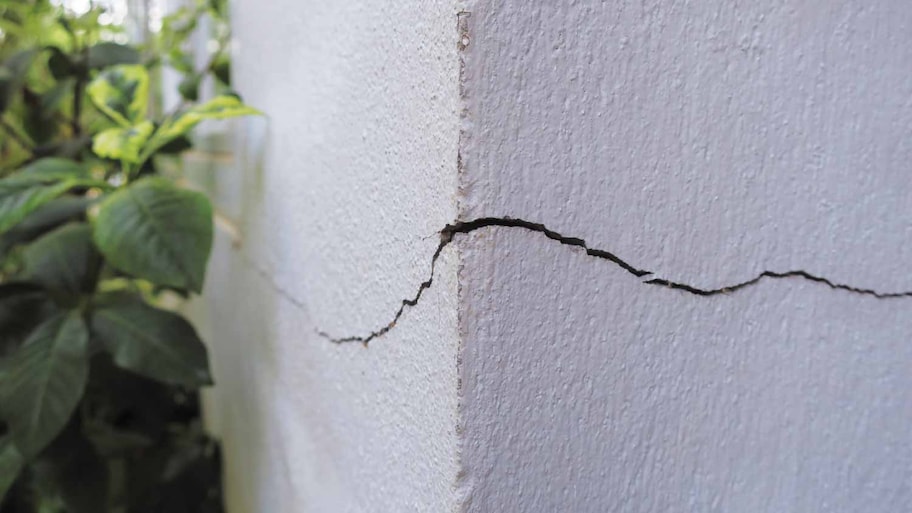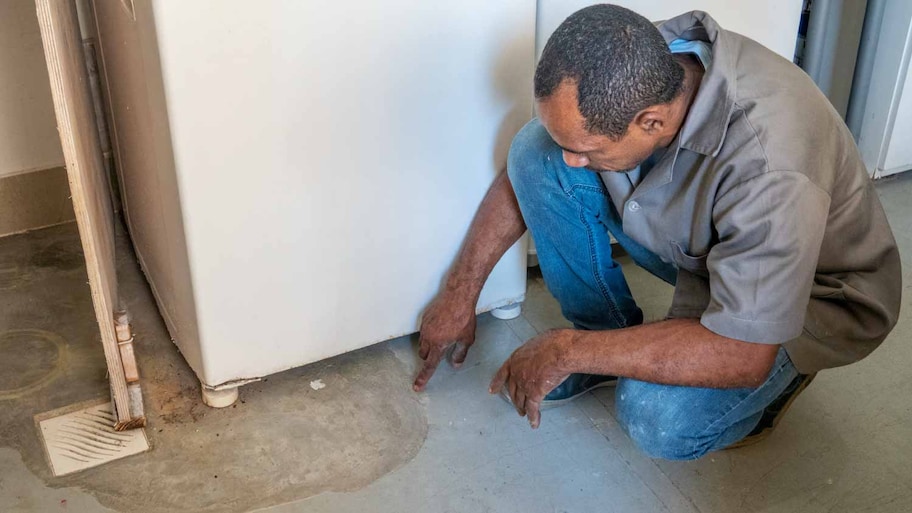Water Damaged Concrete: Everything You Need to Know
Is your concrete cracking? It might be caused by water damage


Highlights
Water damage to concrete can appear as surface cracks, uneven slabs, discolorations and stains, peeling paint, and delamination.
Mold can grow in concrete and cause further damage to your home and health.
Slab leak repairs range from $630 to $4,400.
Concrete waterproofing costs from $3 to $10 per square foot.
While you might not pay too much attention to the water left on your concrete after a heavy storm, water is actually one of the main factors that damage concrete. Water damaged concrete can affect your home’s value and functionality and sometimes turn into severer structural problems.
Common Causes for Water Damage on Concrete
Water damage to concrete can result from several factors, including weather, improper installation, and soil movement.
Lack of Waterproofing
The most common cause of water damage to concrete is a lack of proper waterproofing. A penetrating concrete waterproofing sealer usually works as long as the moisture content is less than 4%. Anything higher than that would require a moisture vapor barrier coating.
Root Growth and Seismic Soil Movement
Root growth is inevitable if your concrete walkway is next to large trees. Along with natural seismic soil movement, they cause settlement cracks in the concrete, making it more vulnerable to water damage.
Plumbing Leaks
Plumbing leaks can cause water damage underneath the concrete surface and eventually result in major foundational damage. Leaking pipes weaken the concrete around them over time and eventually lead to cracking or crumbling of concrete.
Residual Water Damage
Concrete’s porous structure is prone to residual water damage from standing and pooling water or unaddressed water leaks. This causes further erosion into the concrete’s structure. This type of water damage is often seen in basements and crawl spaces built from a concrete foundation.
The Danger of Water Damaged Concrete

Water damage can significantly compromise the concrete structure’s strength and integrity, reducing its durability and life span. For example, you may notice cracks, uneven floors, shattered surfaces, or crumbled concrete.
Mold can also grow from the cement in dark and moist environments, such as basements and crawl spaces, then quickly spread to the remaining undamaged concrete. Left untreated, moldy concrete can cause severe health problems. Plus, the mold can spread from the concrete foundation onto the surrounding wood structure, eventually contaminating your living quarters.
Types of Water Damage
Knowing what types of water damage your concrete has can help address the problem more effectively.
Water Under Concrete
Underground water damage is one of the most common reasons behind sulking, sinking, and crumbling concrete. Water underneath the concrete can erode and soften the material. It can also wash away the supporting soil, causing the slab to sink or crack from settling.
The sloping concrete then directs water toward your home’s foundation, causing soil loss on a much larger scale, which can then lead to foundation settlement. The damaged concrete also becomes more likely to collect debris and form pooling water, which leads to further damage.
Frozen Water Under Concrete
Water expands when it freezes. If water has seeped under the concrete, then as it freezes, it can push the slab upward until the water thaws again. This cycle can eventually crack or shatter the concrete surface, allowing more water to seep in and causing further water damage.
Pooling Water
If your concrete is no longer even, water can pool in the dents on the surface. Pooling water can damage concrete further, lead to muddiness during heavy rains, cause ice pockets during the winter, and become nurturing grounds for insect and pest infestations.
If your concrete surface already has hairline cracks from other reasons, such as water damage from underneath or soil shifting, pooling water would seep into the concrete more easily and lead to deeper erosions.
Signs of Water Damaged Concrete
Fortunately, many clear signs will warn you about water damage on your concrete. Typical signs of water damage include:
Discoloration: Water damage will change your concrete’s surface color. If you notice white or dark spots on your concrete, there might be water damage happening.
Moldy smell: If mold grows in the pores or cracks, you will notice a musty stench coming off your concrete. This is usually more obvious in confined spaces like your basement or crawl space.
Peeling paint: Paint and lamination won’t stay if your concrete is exposed to water. Look for peeling and bubbling paint or delamination, as they are telltale signs of water damage on concrete.
Cracks: Water damage underneath or on the concrete surface leads to cracking. Although water isn’t the only thing that causes concrete to crack, it’s good to look into repairing it because cracks also increase the chance of further water damage.
Rust-colored or efflorescence stains: Unlike stains formed from discoloration and constant spills, these stains are formed from water with iron and salt deposits. They’re a clear sign that your concrete is getting attacked by water.
Identifying Wet Cement
The easiest way to tell if the concrete is wet is to look at its surface. If you see a glossy reflection or a sheen, or a slightly darker color compared to other patches, it’s most likely wet. Wet concrete looks duller and lighter in color.
For more accurate results, invest in a moisture meter. They’re designed to tell you the moisture in different materials. However, using moisture meters on concrete can be challenging due to the material’s hardness. We recommend hiring a pro for accurate moisture assessment if you suspect there is water damage underneath the concrete surface.
Repairing Water-Damaged Concrete
To repair the water damaged concrete, you should start by addressing the root cause, and then move to the actual concrete that has been impacted. If the damage is minor, you can handle the job yourself
Addressing the Root Cause
You should always address the root cause of water damage: where is the water coming from? Try to identify any plumbing leaks, poorly designed gutters and downspouts, or large trees near the damaged concrete. Sometimes, you might be able to tackle the issue yourself, spending on the scope.
Cleaning the Concrete
Remove any debris on the concrete with a large broom, then use a water hose to rinse and clean the concrete thoroughly. Allow the area to dry completely before moving forward with any repairs.
Patching Minor Cracks and Holes
If the damage is minor, you can patch the cracks and holes yourself with a putty knife and mortar or cement fillers, depending on the size of the damage. Make sure you remove any loose material and smoothen all edges before applying the filling material for a stronger binding.
DIY vs. Hiring a Pro
If you are only needing to fill minor cracks and dents, it’s much more affordable to do the repairs yourself. However, you should hire a professional to repair or replace damaged concrete if the water damage is severe. Water restoration for concrete costs $1,300 and $5,600. Slab leak repairs range from $630 to $4,400, and may sometimes be covered by your insurance. Never attempt to replace a cement slab unless you have experience working in the industry.
Also, you may need to hire a different contractor, such as a plumber, roofer, or landscaper, to address the root cause of the water damage.
Finally, for long-term protection, consider hiring a pro to waterproof your concrete. Waterproofing generally costs between $3 and $10 per square foot.
Frequently Asked Questions
You can patch minor cracks and damage yourself using concrete fillers or mortar. Larger damage may require full replacement of affected slabs. However, water damage to your concrete will never disappear unless you address the root cause causing the water to cumulate. To prevent future damage, you can also waterproof your concrete.
Water damage to concrete is often gradual and can take months, if not years, for a concrete structure to be fully destroyed. The process often starts with cracks on the surface, followed by sinking slabs and eventually crumbling cement. Therefore, it is important to repair minor damages early to prevent the situation from worsening.
Use a dehumidifier for indoor concrete and a wet vacuum for outdoor surfaces. Sprinkle absorbent materials like sawdust or cat litter to soak up the remaining moisture. If the concrete is outside, simply wait for a few hot, dry days. If the concrete is inside, make sure you have good ventilation for a few days so that any remaining moisture can completely dry out.
